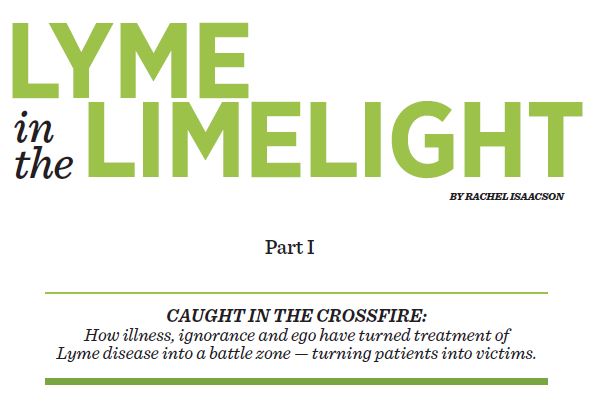Call for your appointment today 914-666-4665 | Mt. Kisco, New York


Lyme in the Limelight, published by Hamodia newspaper, features interviews with veterans in the field including researchers, physicians and advocacy leaders. As a representative of the Infectious Disease Society of America (IDSA) and co-author of the practice guidelines for the treatment of Lyme disease, Dr. Eugene Shapiro gives his perspective on an illness he believes is easy to diagnose and “relatively easy to treat.” I, on the other hand, provide a completely different viewpoint, as lead author of a separate set of treatment guidelines, adopted by the International Lyme & Associated Diseases Society (ILADS).
Following are several excerpts covering areas of disagreement between IDSA and ILADS.
Dr. Eugene Shapiro, Infectious Disease Society of America (IDSA)
“Lyme disease is not difficult to diagnose and it’s a well-defined entity. It’s generally relatively easy to treat. … in some cases it’s more severe. In rare cases, it can be very severe. Symptoms of fatigue, muscular and joint pain are very common. So some people [who have these symptoms] decide they must have a disease — and chronic Lyme disease fits the bill.”
“To be clear, I believe that these patients suffer symptoms, but it’s not causally related to Lyme, or even to another medical condition.”
Dr. Shapiro disagreed with the revised CDC estimate of 300,000 new Lyme cases. “There has been a slow and steady increase in Lyme disease, but the 30,000 numbers are still true. … they [CDC] did a study … I think that study had errors … I do believe that there [might] be an increase in Lyme disease, but it’s in very limited areas. It’s a slow increase but not an epidemic outbreak.”
“There is no such thing as chronic Lyme disease. First you need to be diagnosed with Lyme disease — and most people never had Lyme disease to begin with.”
Dr. Daniel Cameron, International Lyme and Associated Diseases Society (ILADS)
“The Lyme disease patient’s quality of life is the same or worse on standardized scales as diabetes, myocardial infarctions (heart attacks), fibromyalgia and chronic fatigue.”
“ILADS recommends that prophylactic [preventive] treatment should be implemented for at least three weeks, with follow-up after a tick bite [as Bb Lyme spirochetes have the ability to penetrate the body and cells in less than 24 hours following an embedded tick bite]. Whereas, IDSA sometimes recommends a one-time 200-mg dose of Doxycycline. The only study supporting a single dose of Doxycycline demonstrated that it could prevent rashes but did not study whether it could prevent any chronic manifestations of Lyme disease.”
“There are [mainstream] doctors who dismiss Lyme disease (who do not meet ILADS criteria), which leads to needless treatment delays. The delay makes it more difficult to treat. We have not been successful at getting the IDSA to begin the dialogue needed to establish diagnostic criteria.”
(Source: Reprint permission given. Published in the print issue of Hamodia. For more information, visit hamodia.com.)
To read the entire 2-part series, Lyme in the Limelight, click the download button.




All I can say is thanks to Dr. Daniel Cameron and all the other Dr. Cameron out there who have stayed true to your oath as a doctor and persisted regardless of the peer pressure and legal pressure to turn away from the patients afflicted with tick borne illness!!! Also, I strongly hope that Dr. Shapiro is called out one day for his comments in this article and is made accountable. Sometimes words speak louder than actions and his case he has done it again and again. Time to come of the pedestal you put yourself on and admit – maybe just maybe I made a very big error!!!
Thank you Dr. Cameron for all you do. As for Mr. Shapiro. One day he will be counting up all those undiagnosed patients that died and MS and Alzheimer’s patients that could have been helped better with a better test and correct knowledge in the field of Lyme disease. It is my true gut feeling that Mr. Shapiro is more of a corporate man that patients caretaker. Unfortunately I have seen many doctors through the years chasing one diagnosis after the other. You get a good feel for the ones who wanted to be a Doctor for their patients and the ones who0 are in it for the big house and nice cars.